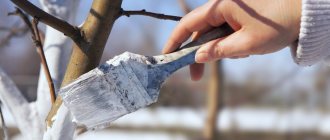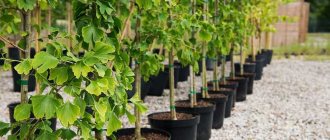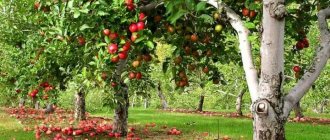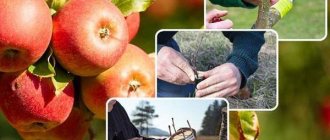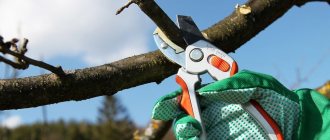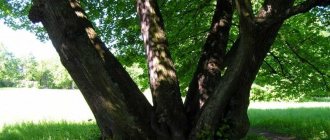Autumn whitewashing of trees is an important stage in preparing the garden for the coming winter. But what tool will cope with this task most effectively? We understand all the intricacies of the process.
The main task of whitewashing is to protect the bark from the bright winter sun and prevent the appearance of frost holes, which can occur due to sudden temperature changes when the snow that has melted during the day turns into ice at night and tears the bark from the inside.
In addition, whitewashing serves as additional protection against insects, which become extremely difficult for them to penetrate under the tree bark. Not to mention the fact that usually, at the same time as the coloring composition, a fungicide is applied to the trunk, which helps protect the tree from pathogens.
- Whitewashing trees: when, how and is it necessary at all?
It is believed that autumn is the most suitable time for whitewashing trees. Is this true and why?
Rules for autumn whitewashing of fruit tree trunks
With the onset of cold weather, when the fruit trees have already given up their harvest and shed their foliage, the garden seems to freeze, plunging into a deep sleep until the first spring rays of sunlight.
This period is the best time to carry out basic activities to prepare the garden for winter. Whitewashing fruit trees in the fall not only increases the yield for the next season, but also protects the garden from many troubles during the cold season. Autumn whitewashing of fruit tree trunks performs several functions at once:
- Reflection of the sun's rays. The winter sun is deceiving. Its rays, especially during the thaw period, often cause burns on the bark of trees. Trunks coated with white lime are able to reflect the sun's rays, thereby preventing overheating and cracking of the bark.
- Protection against temperature changes. Whitewash acts as a kind of thermal insulation “coat”, thanks to which the tree trunk does not overheat during the winter day and does not freeze at night. Such a “fur coat,” acting as an excellent protection for the tree from frost, prevents the formation of frost holes on the bark, which serve as an excellent environment for the development of pathogenic spores and other pathogens.
- Destruction of pathogenic microorganisms. The lime and fungicides included in the composition for whitewashing fruit trees, penetrating deeply under the plant bark, can have a destructive effect on colonies of harmful insects and destroy microorganisms and fungal spores.
How to whiten trees in the garden in autumn
Adding an article to a new collection
Whitewashing is an important part of autumn care for garden trees. A protective layer of lime or paint will protect their bark from temperature changes and sunburn, disease and pest attacks.
Fruit or ornamental trees grow on almost any suburban area. Like many other garden crops, they require proper care from their owners. In autumn, an important procedure for caring for the garden is whitewashing tree trunks, which is carried out in dry weather in October-November.
If you don’t know how to properly whitewash the trees growing in your garden, we will tell you about it.
Variety of choice of whitening compounds
Option #1 – homemade whitewash
The simplest and cheapest option for making a whitening composition is a solution of slaked lime in simple white. The ratio of the components of such a solution is: 2 kg of freshly slaked lime, 300 g of copper or 500 g of iron sulfate per 10 liters of water. Adding 1 tbsp to the solution. A spoonful of carbolic acid can additionally protect trees from attacks by hares and mice.
The lime whitewash solution is stirred in a bucket until it has the consistency of thick sour cream.
Many gardeners have been using this solution since time immemorial. Although the degree of protection of such whitewash is not high enough, due to its affordable price and ease of manufacture, it remains one of the most popular among most gardeners.
In the absence of the opportunity to treat the surface of the trunk with a whitening compound, you can always use another old-fashioned method - coat the trunks with a regular mixture of clay and mullein. To do this, you need to mix 2 kg of lime, 1 kg of clay, 1 kg of cow dung and 250 g of copper sulfate in a container.
Option #2 – ready-made garden mixtures
Garden mixtures based on lime and clay allow the tree to “breathe”.
If lime mortars can only be applied to mature trees, then clay mixtures can also be applied to young seedlings without damaging growth
The only drawback of this solution is that during the winter it is gradually washed off from the trunk. Therefore, it is advisable to whitewash fruit trees again in early spring.
Option #3 – acrylic and water-based paints
Acrylic paint, which contains antifungal and bactericidal components, effectively protects tree trunks from any pathogens.
Such whitewashing is good if the owner does not have the opportunity to promptly check the condition of the tree trunk: whether the protective paint remains on them after winter
Advice. Acrylic whitewash is not a “breathable” base and therefore it is not advisable to use it on young seedlings.
Water-based paint is effective in combating winter frosts, but it is not able to protect the tree from harmful insects. Therefore, before using it, copper-containing components are added to the paint composition.
When is the best time to bleach apple trees?
The most common option is spring whitewashing of trees, but experienced gardeners carry out this procedure at least twice: in spring and autumn. The weather for work must be dry, so that the composition is not washed away by rain immediately, so that it is firmly attached to the bark.
Autumn whitewashing is carried out in October or early November. If the trees were not painted for the winter, then the deadline for spring painting should be postponed to February. If the apple trees overwintered under protection, then they are whitened in March or April. In May it is too late to bleach apple trees.
If the solution has managed to wash off the tree after spring whitewashing, then the protective procedure can be additionally carried out in the summer.
Rules for whitewashing work
You can start whitewashing trees in the second half of autumn, when the rainy season has already passed and the air temperature has settled around 2-3 °C. It is better to choose a fine, dry day for whitewashing.
Whitewashing can only be done on trees that have entered the fruiting season. Young seedlings purchased in the autumn season are not whitened for the winter, since the protective paint only clogs the pores of the tree and does not allow the plant to fully develop, leading to its death.
One or two year old seedlings are simply tied with any covering material. Agrofibre is best suited for these purposes.
Plastic film is far from the best choice, since by retaining moisture, it provokes the development of mold and fungi in the covered area of the trunk.
Preparatory work
Before whitewashing, it is necessary to carefully inspect the trees to eliminate breeding grounds for pathogens. Tree trunks and the lower bases of skeletal branches need to be cleared of dried and diseased bark, old growths and moss. Although lichens do not harm the bark of trees, they clog them. You can get rid of lichens by “washing” the trunks with a solution consisting of 1 kg of salt, 2.5 kg of ash and 2 pieces of laundry soap. All ingredients must be mixed and poured into 1 bucket of hot water, brought to a boil and cooled.
The trunk can be cleaned with wooden spatulas, metal scrapers or brushes, or use serrated saws for this.
You need to work with tools very carefully so as not to damage the plant bark. After cleaning, all wounds and damage must be treated with garden varnish.
If you don’t have garden varnish on hand, you can make your own wound-healing putty. To do this, you need to mix 2 parts clay with 1 part manure, adding copper sulfate and straw dust to the mixture. The putty should be as thick as sour cream.
Carrying out whitewashing of trunks
You can whitewash trees using either a regular brush or a spray gun. However, when working with this convenient device, you should be prepared for the fact that paint consumption will be an order of magnitude higher compared to the traditional whitewashing method. To make painting easier, it is advisable to prepare brushes in advance that match the thickness of the trunk and skeletal branches.
Color palette
The choice of color to paint the surface is an important point. After all, a well-chosen color can easily transform objects, and if we are talking about painting the walls in a room, it will create a special atmosphere.
The color range includes not only colored shades, there are also transparent types that highlight the natural grain of the wood. Belaya kraska and other light colors reflect warmth, which is useful in warm regions. White and light-colored coatings heat up less than dark ones and are therefore more durable.
The production process allows products to be tinted using computer programs; they determine how much pigment needs to be added and what colors to mix to get the desired tone.
White and light-colored coatings heat up less than dark ones and are therefore more durable.
SADOVAYA
BS-01
GARDEN PAINT FOR TREES
Properties:
the paint is water-based. White, matte, antiseptic, fire and explosion proof, gas permeable, odorless. Does not contain solvents or harmful emissions. Purpose:
Designed for painting fruit, ornamental trees and shrubs. The product is environmentally friendly, forms a vapor-permeable “breathable” coating that can protect plants from diseases, pests and sunburn, and increase the winter hardiness of trees.
Garden paint is an effective tool in the fight against crops and pests.
Garden paint is not a material suitable for facade work. In the life of gardeners, it has another, important purpose. This product is used primarily for whitewashing and to protect trees from small rodents, hares and other tree bark lovers. Some lovers of country work, out of habit, use old methods and means of whitewashing, proven by many generations. But today, every manufacturer of paints and varnishes has a more modern product in its range. Those who have once used it no longer return to old methods, since the effectiveness of such a chemical product is much higher.
Paint for garden trees can also be used as a remedy when they are infected with black cancer. This type of building material is made on the basis of water, antiseptic, acrylic copolymers and chalk. In addition, there are also agronomic additives, which, one might say, are a source of life-giving force for the tree.
Actually, such a paint and varnish material is an external product. As a rule, it is only white. Gardeners use this product to protect trees from damage from sunburn and frost damage. It doesn’t matter how garden paint is applied to the tree trunk: with a brush, roller or spray - it can protect even sensitive heat-loving plants from icing. In addition, such a station wagon is also used for therapeutic and prophylactic work, preventing infection or damage to trees and shrubs by harmful insects. All chemicals in this category are completely safe and do not cause any harm to trees or shrubs. However, this product perfectly destroys pests that are dangerous to the tree.
Paint for garden trees, based on acrylic latex, is deservedly popular in its segment. The huge advantage that acrylic paint has is its rapid absorption and the formation of a durable, breathable film on tree trunks.
It is very interesting that paint for garden trees can be used for other purposes. Although it is intended primarily for wood, it is also used for other purposes. For example, experienced summer residents paint the walls or roof of a greenhouse to protect the plants in it from sunlight.
In addition, wooden garden furniture painted with this paint will also be protected from pests. For example, an outdoor wooden bench, a favorite resting place for summer residents after exhausting work, will delight you with its convenience longer, despite the unfavorable external environment. This is due to the fact that garden acrylic paint forms a durable film, which will protect it from moisture. And, importantly, garden furniture treated with this product lasts longer and looks great against the backdrop of trees with beautifully whitewashed trunks.
The sale of such a product for garden trees, shrubs and even furniture is carried out not only in construction and finishing materials stores. This paint and varnish product can also be purchased in gardening stores. Recently, a new trend of shopping through an online store has emerged. These services that offer goods and services are very convenient. Moscow was the first to appreciate such a convenient shopping option, because this type of shopping frees you from exhausting shopping trips with a heavy load in your basket. In addition, most of these services offer free and convenient delivery.
The quality of garden paint purchased from an official manufacturer’s online store always guarantees quality and absence of counterfeiting. After all, in order for fruit trees or shrubs to delight with their young shoots or fruits, they need high-quality care products. However, it is not enough to purchase high-quality paint and varnish material - it still needs to be used correctly.
Before applying such paint, the surface to be treated must be properly prepared. First of all, it is necessary to remove all types of contaminants from the surface: dust, old lime paint, moss and lichens, if any. Dead bark also needs to be removed. Only after this can you apply garden paint to the trunk and its wounds.
To make your garden and shrubs happy, you need to provide them with proper care using high-quality and reliable products, of which there are a great many on the market now. In this case, fruit trees will thank you with a rich harvest.
Garden paint - a modern alternative to traditional whitewashing of trees
Garden paint is a water-dispersed paint and varnish (but not construction) material on an acrylic or latex base for painting gardening trees and shrubs. Serves to protect them in winter from frost damage, in early spring (February-March) - from sunburn, and to destroy pathogens. Kills and prevents the penetration of insect pests into wood, prevents them from rising into the crown, and can also be used for decorative purposes.
Paint for garden trees is intended, first of all, to protect the trunks and skeletal branches of trees from sunburn. The fact is that in early spring the sun is very bright and strongly heats the bark; The south side is especially susceptible to this. At night, when the temperature drops to minus, a sharp contraction of wood tissue occurs, causing the bark to crack. The white color reflects the sun's rays and prevents the bark from heating, which is the main purpose of whitewashing trees. Moreover, the meaning of this procedure is contained in the word “whitewashing” (and not painting against pests or coating): to make the trunks white.
Acrylic water dispersion paint purpose:
Water-dispersion acrylic paint for garden trees, weather-resistant. After using this paint, you can move on to painting facades, and for this there is facade paint based on Finnish acrylate styrene.
— therapeutic and prophylactic painting of trunks and bases of skeletal branches in order to increase the winter hardiness of the bark of fruit and ornamental plants;
- protecting them from sunburn and frost damage (rupture of the bark under the influence of a large temperature difference);
— disinfection of trunks and branches, destruction of pests;
— protection from rodents and hares;
- covering the cuts after pruning in the garden and nursery.
Acrylic paint, water dispersion, consumption:
Saplings, young trees - 50-70g, fruit-bearing trees - 180-200g. for a single layer coating.
State registration of the Eurasian Economic Community
Environmentally friendly product
All products have certificates and are environmentally friendly.
Water dispersion acrylic paint storage:
Store in a tightly closed container at a temperature not lower than +5C
State registration of the Eurasian Economic Community
View the entire range of acrylic water dispersion paints.
Sales department /
High-quality paint for garden trees is important in the life of gardeners. It is intended for whitewashing and protecting trees from small rodents, hares and other tree bark lovers. Whitewashing is often used for this purpose, but in the modern world there are better methods that quickly and effectively cope with the task. Those who have tried acrylic paints for garden trees no longer return to old methods of plant protection. It is much easier to buy paint for garden trees for the season than to experiment with dubious drugs and substances.
Effect of paint
The composition of the paint helps prevent the development of mold and rot, and it can also be used to treat wounds after pruning tree branches. In spring, the bright sun greatly heats the bark. At night, wood tissue contracts under the influence of low temperatures, causing the bark to crack. The white color of the paint is able to reflect the sun's rays and prevent the bark from heating up, protecting trees from burns. itself for whitewashing garden trees is completely safe for trees and for humans and does not harm their health.
Do you need to bleach apple trees?
Fruit trees, including apple trees, need whitewashing. Applying a light composition to the bark in the spring will protect against injury due to the bright sun. Tree trunks are dark in color, so they heat up significantly during the day. At night in spring, the air temperature drops noticeably. Because of this difference, the bark cracks. Infections and insects will quickly get into these cracks, leading to disease and death of the plant. Bleached trunks will reflect light, heat up less, and will not crack. Such protection is needed for both young and old plants.
Important! Painting trunks with whitewash in the fall is a pest control measure. Various insects inhabit the bark for the winter. With the help of whitewashing, trees are disinfected from adult insects, larvae, eggs, and pupae.
Paint composition and application
The composition of paint for garden trees includes: copolymer acrylic dispersion, mineral filler, antiseptic (insecticide), targeted agricultural additives, water. Each component provides an indispensable service to gardeners when caring for trees. It is important to buy paint for garden trees and use it correctly, thereby ensuring the desired effect. Before application, the surface must be cleaned of dirt. Dust, lime paint, moss and lichens, dead bark should be removed with a hard bristle brush.
After mixing the paint, you can apply it in one or two layers using a brush, roller or spray. The air temperature should be at least 5°C, the interval between applications should be at least 30 minutes, then it will be time to completely dry and acquire protective properties - this is approximately 48 hours. Tools and containers can simply be washed with water after finishing work.
Basic rules for painting
When preparing to whitewash a garden, it is important to properly prepare the tree. The trunk of the plant must first be removed from the peeling parts of the bark, and the cracked areas must be carefully cleaned. The removed bark must be removed away from the garden and burned. It contains parasite larvae, which, after the winter awakening, can continue to destroy the plant.
Damaged areas on the trunks should be carefully treated several times. First apply the first coat of paint, then, after drying, re-treat the area. One layer of the substance is applied to regularly treated surfaces.
Autumn painting is best done after the end of the heavy rainy season. Spring manipulation - before the onset of stable warm temperatures. When the soil warms up, insect larvae become active in the plant bark, which worsens the result of its treatment.
Paint for garden trees is applied using a brush, roller, or special sprayer. When choosing the best painting option for yourself, you should also take care of protecting your own skin. It is better to carry out manipulations with gloves and safety glasses. This minimizes the possibility of injury and damage to the skin.
Source: green-design.pro
Paint effectiveness and impact
Acrylic paint for garden trees is an indispensable assistant for gardeners. It has features such as disinfection, resistance to atmospheric conditions, increases the resistance of plants to frost, protects the bark of trees from ultraviolet exposure, replaces garden varnish in the treatment of cracks and wounds, destroys insect pests, forms a vapor-permeable coating - a thin breathable film that does not is an obstacle to natural air exchange.
Antimicrobial and antifungal components prevent rotting and germination of moss and lichen spores. It is recommended to paint trees and shrubs in early spring, autumn and summer on the trunk and branches of the first order from the ground and as high as possible from the trunk and forks of the branches.
To make your garden and shrubs happy, you need to provide them with proper care using high-quality and reliable products, one of which is acrylic paint for whitewashing garden trees. In this case, fruit trees will thank you with a rich harvest. Acrylic paint for whitewashing garden trees combines low price and high efficiency.
How to prepare wood for whitewashing?
In order for the treatment of apple trees to have an effect, it is important to properly prepare them for such a procedure. It includes three mandatory steps.
- Cleaning. The trunks of apple trees are removed from old bark, which is especially generously covered with lichens. Large segments are removed with a spatula or wooden spatula. Final cleaning is carried out with a wire brush. This procedure is best done after rain or when there is high humidity. Then the bark will be easier to remove. Removed parts must be burned to prevent the spread of infections and garden pests. For convenience, you can spread an oilcloth around the tree before cleaning.
- Disinfection. This stage of preparation for whitewashing is best done in dry weather so that rain does not wash away the disinfection solution. It can be done in several ways. You can spray the apple tree with a spray bottle of copper sulfate solution, paying special attention to the damaged areas. You can also wash the barrel with a solution of ash or ash with laundry soap. The main thing is to work with gloves. To do this, dissolve 2 kg of wood ash and a bar of laundry soap in a bucket of water.
- Covering wounds. After removing the old bark, cracks, depressions, and wounds may remain on the trunk of the apple tree. They must not be left open. Such recesses should be covered with clay mortar or special garden putty. A good protective agent is a mixture of manure and clay diluted in water. Only after these three stages can you begin to whitewash the apple trees.
